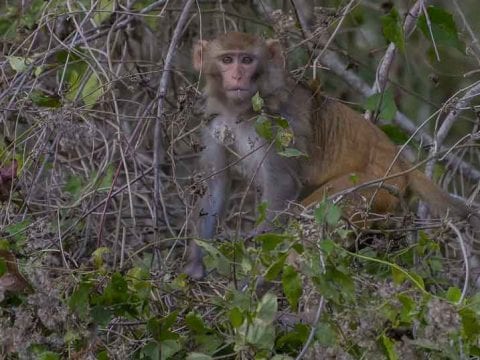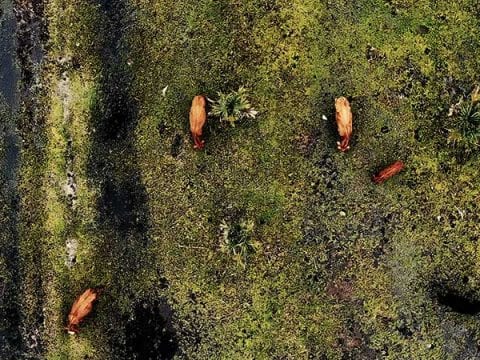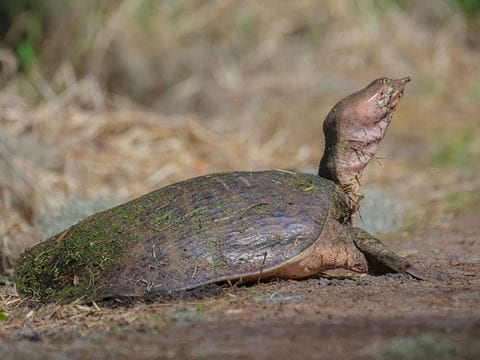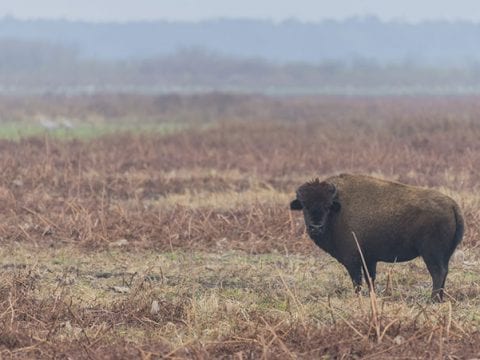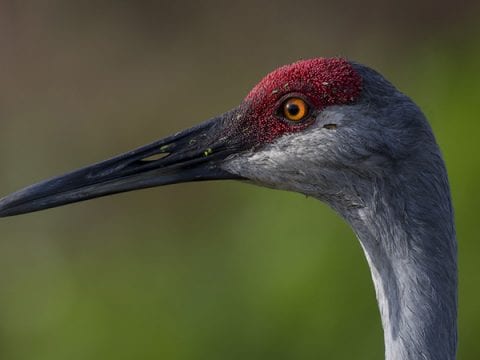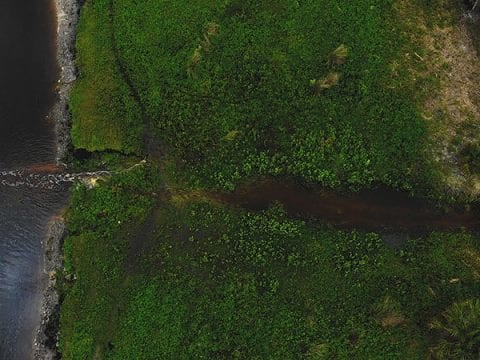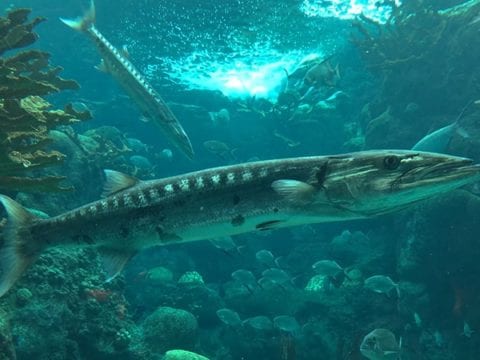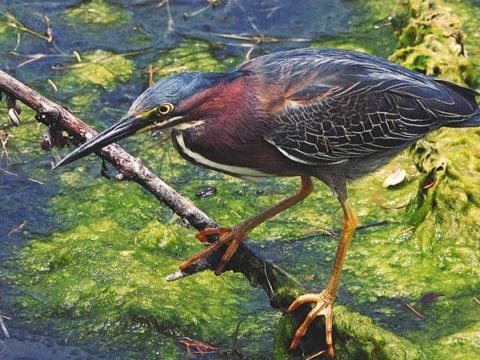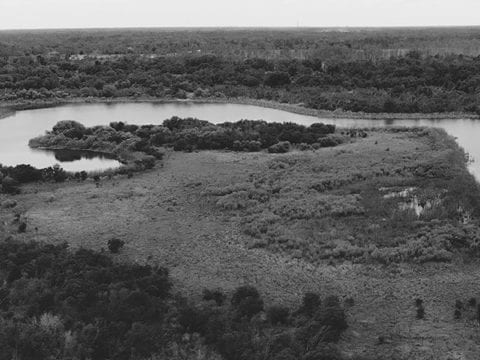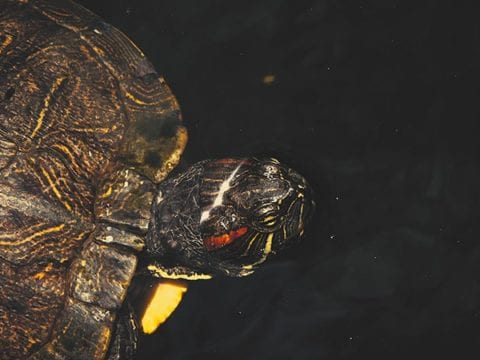Table of Contents
On my recent hike during a rain storm, I ended up at a lake in the early morning hours to find a number of snowy egrets hunting for fish. In this 4K wildlife video, you’ll see the egrets flying slowly in the air and quickly dipping their beaks into the water to catch minnows. I slowed the footage down to 60% so you could see more detail on how they do this.
In the past, I’ve seen these birds hunt but they were always standing in the water and not flying. This was a first for me to see. Here are some snowy egret facts.
Snowy Egret Facts
- Scientific Name: Egretta thula
- Spanish: Garceta Nívea
- French: Aigrette neigeuse
- The beautiful plumes of the Snowy Egret were once in high demand. They made great additions to women’s decorative hats. In 1886, the plumes of these birds were valued at $32 per ounce. Due to the high demand, Snowy Egrets were put on the endangered species list.
- The bird is now protected under the Migratory Bird Treaty Act in the United States.
- The Snowy Egret is the American counterpart of the Old World Little Egret.
- The name Snowy Egret comes from the snowy white plumage each bird has during breeding season.
- On record, the oldest Snowy Egret was 17 years, 7 months old. In 1970, it was banded in Colorado and found in Mexico in 1988.
- Their call is a low croak
- The Snowy Egret, the most elegant heron of all the herons is known as several different names: little egret, little snowy, lesser egret, little white egret, little white heron
- They use one foot to make a circular motion in the water so that they can stir up their prey
- Their neck is shaped like an “S” when they are on flight
- Mating pairs will only recognize each other when they are at the nest. Upon returning to the nest, each has to perform an elaborate greeting ritual to save themselves from being attacked as if they were an intruder
- Snowy Egrets are carnivores who like to eat snakes, amphibians, small fish, fiddler crabs, etc.
Identification
The Snowy Egret is known as the most elegant of the herons due to its white plumage. The bird has a slim black bill, long black legs and bright greenish-yellow feet. Their feet play a part in the herding of small aquatic animals while foraging.
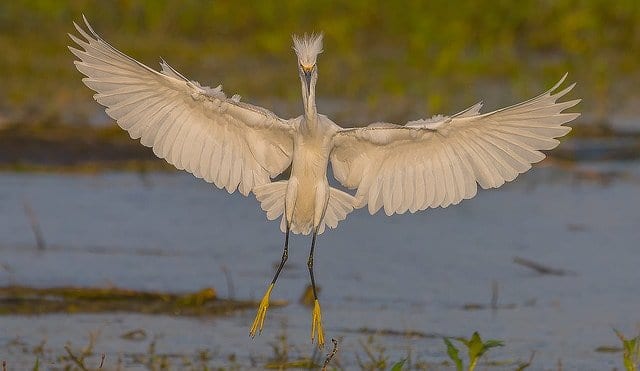
Snowy egret coming in for a landing
During breeding season, the Snowy Egret goes through an array of physical coloration changes. The upper section of their bill is typically yellow but during breeding season, it will turn red. Their feet will darken during breeding season to a yellowish-orange. The bare skin on their face changes from yellow to a red hue.
Size
Length
- 25 inches
Weight
- 370 grams
Wingspan
- 40 inches or more
Behavior
Snowy Egrets walk upright with their wings tucked into their body. This allows the bird to make quick directional changes when foraging for prey. They are more active at dawn and dusk, rest during the day, are beautiful flyers but they do not swim. They enjoy self-maintenance likes grooming their wings, scratching their heads to remove insects and bathing. Snowy Egrets are very social birds and enjoy foraging in groups with others. They avoid predators like raccoons, poisonous snakes, hawks and owls due to this.
Habitat
Snowy Egrets winter in saltwater lagoons, freshwater swamps, mangroves, temporary pools and grassy ponds while they forage wet fields, shallow reefs and beaches for food. They are permanent residents of Central, South and North America. They frequent the Atlantic coast north to Virginia Beach and along the Gulf Coast.
Breeding Snowy Egrets will nest with other water birds in many different types of habitats like motts, inland wood islands, swamps and coastal islands. They like to put their nest on the ground in very thick vegetated areas.
Diet
Snowy Egrets eat frogs, worms, fish, insects, crustaceans, reptiles, crayfish, mice, snails etc. They are generally seen foraging shallow waters like tidal channels/flats, freshwater/saltwater marshes, lake edges and ocean inlets. They can even forage while hovering in the air. They use a technique called “dip-fishing” where they fly with their feet over the water while stalking their prey in shallow water. Another tactic used is one where they stand still and wait patiently to ambush their prey. They use their feet to paddle in the water or probe through the mud to look for their food before striking with their bill. They can feed while hopping, walking, standing or running.
The video above shows a snowy egret hunting for minnows in a more traditional way by standing in a body of water very still.
Reproduction
Nesting
Snowy Egrets breed and nest in close colonies together. Usually, they will breed right along other species of water birds. Typically, in isolated places with a lot of thick vegetation like dredge-spoil or barrier islands, swamps, marshes and salt marsh islands. They will change location from year to year while foraging mangroves and saltmarshes for food. Male Snowy Egrets will fight for breeding territories while also choosing a nest site. He also uses a series of courtship displays to attract a mate. He pumps his tail, calls out, points his bill up toward the sky and performs aerial displays while being surrounded by a group of other birds. The male bird already starts building a nest even before he’s found a mate. Once they have actually mated, the female will work on the nest with the supplies (small sticks, grasses, twigs, sedges, moss) that the male brings her. It is 14-18 inches wide and 8-13 inches high.
Once he has found a mate and the two have paired up, the duo will defend their nest from predators like owls, raccoons, crows, snakes and alligators. The nest is usually located in or on top of the branches of a tree, on a shrub or a wooded vine.
Sometimes, Snowy Egret males will mate with other heron species to produce a hybrid offspring.
Eggs
Female Snowy Egrets lay 2-6 eggs into their nest. Both parents spend time incubating the eggs for 24-25 days and when they change out, they present each other with a stick as if they are passing a baton to the other. The eggs are pale blue-green, 1.6-1.7 inches long and 0.9-1.3 inches wide.
Younglings
When younglings are born, they are semi-helpless and covered in white down. Both parents feed their young but sometimes, the last youngling to hatch starves. Younglings look much like adults except the base of their bill is much paler and they have a greenish-yellow line that runs down the back of their legs.
At 20-25 days old, younglings will start to clamber out of the nest and typically will begin to fly before day 30.
They reach sexual maturity when they are two years old and can start the process of reproduction all over again.

